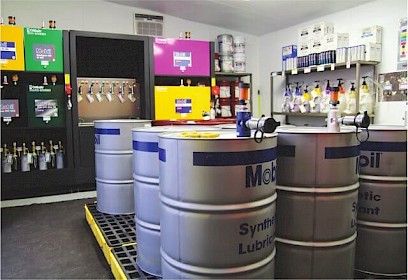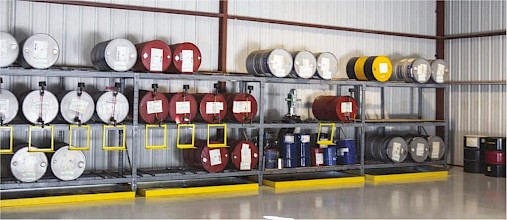Store, Plan, Execute, Excel: (R2P) Lubricant Storage and Lube Room Factor Overview
Around the industry these days, we all hear similar things about keeping in-service lubricants clean, cool and dry. But what about the lubricants that aren’t in-service yet? Those lubricants are just as (if not more) important to keep clean. In many ways, the future of your lubricants is the future of your machinery. Just as you store spare parts properly so they are ready for service without compromise and at a moment's notice, your lubricant storage should be a top concern for your facility’s lubrication program. The way a facility stores and prepares its lubricants for service says a lot about the facility’s lubrication program. On the Ascend™ Chart, the Lubricant Storage and Lube Room (R2P) Factor is included on the Platform Level of the “Lubricant Reception and Storage” Lifecycle Stage. This identifies R2P as a foundational factor to lubrication excellence.
The first thing a technician should think about when receiving new lubricants is, “What are the quality control processes for the reception?” But for the purposes of this article, we will assume perfect quality control processes are in place so we can focus on the lube room and storage aspect of lubricant reception.
So, now that the technician has properly received the new lubricants, it’s time to think about storing them properly. But where? Maybe that back corner of the lot, or out by the old maintenance shop? Either way, they can just be propped up out in the open and exposed to the elements, right? Wrong. Believe it or not, such circumstances are quite common at the average facility, but they are far from world-class storage practices.
Having a dedicated space to properly store and handle lubricants is critical to keeping the lubricant ready for service because doing so prevents lubricant contamination and degradation. This allows the lubricant to not only perform better for longer, but it also allows the overall machine to perform better, leading to less repair work, less downtime and smoother operation. Put plainly, every plant needs a lube room.
Building A Lube Room
Building a great lube room is essential to a great lubrication program. Think of the lube room as your facility’s War Room. This is where the planning and strategizing happens. This is where the battle for best lubrication practices is won! The lube room is also good for other lubrication-related tasks like inspecting oil filters or topping up, storing and cleaning sealable and refillable containers. It all starts with the lube room or lubricant storage space; the size of the room depends primarily on the size of the plant and the number of lubricated assets, but there are some basic requirements for a proper lube room:

- Solid walls and a roof Well-ventilated space
- Sealed concrete floors with a non-skid finish
- Conspicuously marked aisles, work areas and equipment locations
- Climate and humidity controlled (dehumidifiers, air-drying systems, etc.)
- Safety measures in place, (e.g. first aid kits, fire extinguishers or fire suppression system, eyewash station and conspicuously placed evacuation routes).
- Workbench
- Computer station for lubrication and maintenance tasks and inventory
- A clean and orderly environment
- Now that the space requirements are established, the true potential of the lube room can be found through consistently utilizing best-practice storage and handling solutions. You will need the right equipment to properly outfit the lube room to prepare for short- and long-term storage needs. Each facility should outfit the lube room to accommodate the number of lubricated assets in the facility and the quantity requirements of each of the assets. A working list of lube room equipment for most facilities would be:
- Storage racks for drums
- Bulk oil containers w/ dispensing system
- Fire-safe cabinets for storing and organizing greases and other small-quantity lubricant containers
- Storage rack or cabinet for sealable and refillable containers
- Filter carts, each filter cart being dedicated to one lubricant to prevent cross-contamination.
- Proper disposal receptacles for oily rags and used oil.
- Reclaimers to recondition used oils
- Oil and grease transfer pumps
- Maintenance supplies such as rags, various fittings, spare filters, reservoir screens, absorbent materials to control spills, desiccant breathers etc.
Every successful lube room should also have defined policies and procedures in case of spills, wastage, accidents or any unexpected lubrication issues. The organization is absolutely key to not only a successful lube room but most other work that a lubrication technician will perform. All tools and applicable handling devices should be stored in cabinets with doors. Each storage area in the lube room should be marked specifically for the tool or piece of equipment that is to be placed in that spot. This helps maintain proper organization and allows for efficient use of the available space.
Lubricant Storage
Grease – While grease is widely used in most industries, it is also the most common lubricant to be stored improperly. Store grease vertically with the plastic cap up. This method of storage decreases the amount of oil bleed that may occur in greases, particularly for long term storage. I’m sure most of us have experienced opening a cabinet to get a new tube of grease only to see the oil pooled on the shelf. This is a result of the oil separating from the thickener-leaving it unusable and wasted.
Grease guns containing grease should be stored differently. Grease guns should be stored horizontally to prevent oil from bleeding out of the bottom of the grease gun. This allows for the next technician to choose the grease gun according to the lubricant label (such as a LIS tag) and not have to worry about pumping mostly thickener into the component. Remember, the oil and additives provide lubrication while the thickener just helps keep it in place.
Oil Drums – Just as grease is often stored improperly, we also see a lot of drum oil waste as well. When storing drums, each facility must utilize the First-In-First-Out method, also known as FIFO. This inventory method helps keep oil drums from being left in storage too long and cycled into service before they reach their storage life. Also, good drum storage practices like this can help keep oil drums from being over-ordered, double-ordered or generally wasted through a number of other mistakes resulting in excess drums and poor cost control.
But how you might ask, is having excess lubricant is a bad thing? Imagine the lube storage area becomes full due to over-ordering. Now perhaps the drums must be stored outside. While this can be done properly, most facilities in this situation would not take the time to adequately protect those drums. So there they sit, out behind the shop or some other open space with no cover and exposed to every environmental contaminant nature can throw at them. Soon, you’ll have water pooling on top of the drum. Temperatures begin to fluctuate, causing the drums to expand and contract - to "breath". When the drum breathes, it creates a vacuum and the water on top of the barrel slowly gets sucked in, even if the bung was never opened. Of course, once this water is introduced it begins to prematurely degrade the lubricant.
Best Practice Methods to Storing Oil Drums
Indoor (Preferred)
 Drums should be stacked horizontally and no more than two high
Drums should be stacked horizontally and no more than two high- Drums should be stored on proper drum storage racks utilizing FIFO to maintain a good rotation of stock
- If no rack is available, at least store barrels horizontally with the bungs at the 3 and 9 o’clock positions
- Bungs are kept tightly sealed, perhaps with a high-quality desiccant breather attached to prevent contamination.
- Always utilize a filter or transfer cart when transferring oil.
Outdoor (If Necessary)
- Shelter the drums the best you can-tarp, shed honing, etc.
- Lay drums horizontally (3 & 9 o’clock)
- If drums must be stored vertically due to space constraints, utilize some type of covering and/or tilt the barrels to allow water to drain
Bulk Oil Storage and Dispensing System – Of all the lubricant storage options, bulk storage is the best practice for oil storage and contaminant prevention. There are many different companies providing a variety of styles for large-scale bulk oil dispensing systems. There are a few key characteristics to consider, rather than a specific brand. To start with, it should have a filtering and circulating system to control contamination and maintain fluid health while in storage. The choice between steel containers and polyethene containers depends on the budget and specific goals of each company. Most dispensing systems on these storage units are similar with a pressurized and filtered dispensing tap, built-in spill containment and they also save space for other equipment.
After considering these lube room and storage requirements, ask yourself, “How would my facility score in this factor?” Your factor score can tell a lot about how your lubrication program is going overall, how it is maintained and usually where a good starting point is for best-practice improvements. Lubrication training can also help decide where to start improving first. Out of the seventeen foundational Factors at the Platform Level on the Ascend Chart, Lubricant Storage and Lube Room (R2P) is one of the most important for overall lubrication program success.
